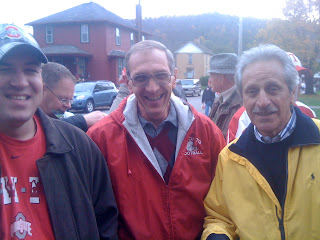It's neither Cooperstown, New York nor Canton, Ohio, but few towns the size of the Gem City can claim that five professional hall of fame athletes once called the ball fields of Toronto, Ohio home.
Receiving his first shot of professional football here at the old Kaul Field was Wilbur "Fats" Henry, an All American lineman from the College of Washington and Jefferson. "Those were rough and tumble days," the late Tom McKelvey said about the 1920s. "Doc Kilgus was the owner of the Toronto Tigers and was trying to build up the team with outside players. One of those was Fats Henry, fresh out of college."
Henry would go on to play and coach for the Canton Bulldogs, and in 1926, he brought up Toronto native John Comer for one game. Wearing number 3, Comer carried the ball once for one yard, giving him the distinction of being Toronto's first professional football player.
Henry is both a member of the College Football Hall of Fame and the National League Hall of Fame.
The Gem City athlete to next join the professional football ranks was Clarke Hinkle, after whom the high school stadium is named. Carl Snavey, his coach at Bucknell University said of the Lackawanna Express, "Without a doubt, the greatest defensive back I have ever coached." Hinkle became a three-time All American at Bucknell and then went on to play with the Green Bay Packers from 1932 to 1941, a period this fullback-linebacker became the NFL's all time leading rusher with 3,860 yards.
In 1964, the NFL enshrined Hinkle in Canton and the NCAA in 1971.
Two decades later, continuing the proud gridiron traditions of Toronto was Don Sutherin, a 1954 graduate of THS.
Sutherin, of course, is best remembered for kicking the winning field goal of the 1958 Rose Bowl for Ohio State, but, locally, he and fellow classmate George Deiderich have the distinction of being the only two future professional football players to have paired at THS at the same time, from 1949 to 1953. During their senior season, the two future Canadian Football League players performed on a squad that produced four wins, four losses and one tie.
The New York Giants drafted Sutherin as a defensive back in 1959. He played for the Giants part of that season and then played with the Pittsburgh Steelers the remainder of the year and the 1960 season. Sutherin then took his talents north to the Hamilton Tiger Cats and played in the CFL for 12 years, participating in eight Grey Cups, his team winning four.
By the time he retired, Sutherin held 18 CFL records. He was inducted into the CFL Hall of Fame in 1992.
Toronto contributed to the Baseball Hall of Fame, as well. Pittsburgh Pirate shortstop Honus Wagner often brought several teammates to barnstorm against local clubs. He also played for the Toronto Athletic Club.
In
The Era of Elegance author Walter M. Kestner wrote, "Wagner, in the twilight of his years of his career, played in Toronto where he alternated with Lawrence Hughes on the all star team managed by Doc Kilgus."
Kilgus also recruited for the all star squad Boston Red Sox outfielder John Bates and Chicago Cub catcher Tom Needham, both from Jefferson County.
One hall of fame athlete who did get away from the Gem City was Rollie Fingers, whose father George played for Class D Williamstown in the Mountain State League in 1938.
The Fingers family resided at 601 Clark Street. Around when Rollie was ten years old, father George, fed up with working at Wheeling Steel in Steubenville, decided to move the family to California.
Rollie went on to play 18 seasons in the major leagues, pioneering the role of closing pitcher while recording 341 career saves.
He was inducted into Cooperstown in 1992.













